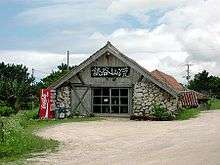Ryukyuan pottery

Ryukyuan pottery (琉球焼, or Okinawan language: 焼物 ; Yachimun) include earthenware and stoneware items that are traditionally made on the Ryukyu Islands in east Asia.
History
Ryukyuan pottery first appeared during the Gusuku period (c. 1100s-1400s), when it was introduced from China.
Tsuboya became the centre of production in 1682 after the kilns of Chibana, Wakuta, and Takaraguchi were consolidated under the Ryukyu Kingdom government. The two sub-types of Tsuboya ware were the generally unglazed Ara-yachi and the glazed Jō-yachi.[1][2]
Most of the kilns had to move out of Tsuboya after the end of the Pacific War due to the smoke they produced. Production moved to the villages of Yuntan (読谷村) and Ujimi (大宜味村) and they continued the tradition of Yachimun.[3]
In addition to dishes, vessels, and roof tiles, Ryukyuan pottery is especially known for the production of funerary urns, and shisa, lion-like guardians placed on rooftops and at gates to protect homes and other spaces from evil spirits.[4]
References
- ↑ "壺屋焼 of 沖縄の工芸品". okinawacrafts.com. Retrieved 2016-11-08.
- ↑ "The Contrasts of Potters in Okinawa - Japanese Art Gallery in Paris - MIZEN Fine Art". mizenfineart.com. Retrieved 2016-11-08.
- ↑ "琉球焼 of 沖縄の工芸品". okinawacrafts.com. Retrieved 2016-11-08.
- ↑ "Tsuboya Yachimun Pottery Street - Naha Okinawa Japan". okinawa-information.com. Retrieved 2016-11-08.
Further reading
- Michiaki, Kawakita ... [et al.], Craft treasures of Okinawa, translated and adapted by Erika Kaneko, Kodansha International, Tōkyō, 1978
- Publication Committee of the art of Okinawa, The art of Okinawa: Pottery, Okinawa Times Co, 1989
- Stockton, Elizabeth, Traditions of Tsuboya, Ryukyu Bunka-sha, Naha, 197-
- Suzuki, Hisao, Sugimura, Tsune, Living crafts of Okinawa, Weatherhill, New York; Tōkyō, 1973
- Tsuboya Pottery Museum, Guidebook of the Permanent Exhibitions, Naha Municipal Tsuboya Pottery Museum, 2000
- Uemura, Masami, A Potter Jiro Kinjo, Okinawa, Japan, 1988
External links
![]() Media related to Ryukyuan pottery at Wikimedia Commons
Media related to Ryukyuan pottery at Wikimedia Commons
- Tim van der Linden. "Yachimun pottery | shisaa.jp". shisaa.jp. Retrieved 2016-11-08.
- "Traditional Okinawan pottery". loststory.net. Retrieved 2016-11-08.